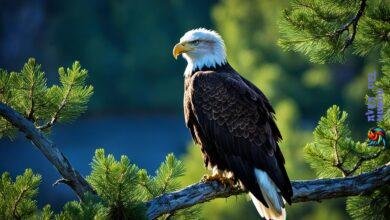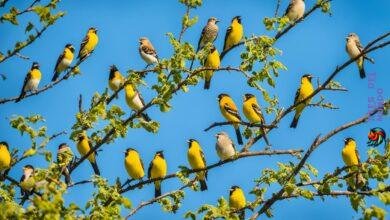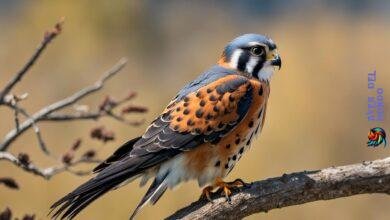Did you know that there are over 9,300 tracked birds captured by scientists across the Western Hemisphere? These birds represent the journeys of 458 avian species that breed in the United States and Canada. This vast network of migratory birds crisscrosses the continent, creating a spectacle of nature that is both awe-inspiring and critical to the ecosystem.
Now, thanks to the new Bird Migration Explorer platform created by Audubon and nine founding partners, you can delve into the fascinating world of bird migration like never before. This comprehensive online tool provides a colorful map showcasing the migration routes of these incredible creatures, allowing you to explore their movements, discover birds at specific locations, and learn about the challenges they face along the way.
Explore by Species on the Bird Migration Explorer
On the Bird Migration Explorer platform, you have the opportunity to delve into the fascinating migration patterns of specific bird species. By searching for a particular bird, such as the American White Pelican, you can visualize its annual migration route on an interactive map provided by the platform. Let’s take a closer look at the bird migration patterns in the USA and the North American bird migration routes.
For instance, American White Pelicans breeding east of the Rocky Mountains follow a migration path primarily south and east toward the Gulf of Mexico. On the other hand, those breeding to the west undertake their journey southward, heading to California and western Mexico. Witnessing these migratory routes of the American White Pelicans can offer you valuable insights into their incredible journeys and the habitats they traverse.
In addition to visualizing migration routes, the Bird Migration Explorer platform also provides comprehensive information on the natural history of each species. This includes details about their breeding, feeding, and wintering grounds. Gain a deeper understanding of these remarkable birds as you explore their patterns and discover the diversity of their habitats along the way.
The platform also sheds light on the conservation challenges that migratory birds face. Bird conservation has become an increasingly important issue due to habitat loss, climate change, and human activities. By understanding the migration patterns of these species and the obstacles they encounter, we can work towards implementing effective conservation measures to protect their habitats and ensure their survival.
Migration Patterns of Selected Bird Species in the USA
| Bird Species | Breeding Range | Wintering Range | Main Migration Route |
|---|---|---|---|
| American White Pelican | East of the Rocky Mountains | Gulf of Mexico | South and east migration route |
| American White Pelican | West of the Rocky Mountains | California and western Mexico | South migration route |

Discover Hotspots on the Bird Migration Explorer
The Bird Migration Explorer platform offers an exciting feature that allows you to discover the best bird watching spots in the USA and other regions. By exploring hotspots across the Western Hemisphere, you can immerse yourself in the incredible diversity and abundance of birds in these areas.
Whether you’re a passionate bird enthusiast or someone looking to embark on a unique and rewarding adventure, the Bird Migration Explorer is your go-to resource for finding the perfect bird watching locations. With just a few clicks, you can unlock a world of opportunities to observe and appreciate the beauty of migratory birds.
Find Your Ideal Bird Watching Spot
With the Bird Migration Explorer, you can select a featured area and gain valuable insights into the bird species that occur there. This information allows you to plan your bird watching trips strategically, ensuring that you visit the locations where your favorite birds can be found.
Whether you’re interested in observing majestic raptors soaring through the sky, colorful warblers flitting among the branches, or elegant shorebirds foraging along the coast, the Bird Migration Explorer has you covered. With its extensive database and comprehensive mapping features, you’ll be able to discover the best bird watching spots that suit your preferences.
Unparalleled Biodiversity and Awe-Inspiring Sightings
The hotspots featured on the Bird Migration Explorer are renowned for their remarkable biodiversity. These areas serve as important stopover points and breeding grounds for countless species, attracting flocks of migratory birds each year.
Imagine standing amidst vast wetlands teeming with waterfowl, witnessing the spectacle of thousands of shorebirds taking flight, or getting up close and personal with a dazzling array of songbirds in lush forested areas. The possibilities are endless, and the Bird Migration Explorer helps you unlock these extraordinary experiences.
Here’s a sneak peek of some of the best bird watching spots in the USA, as highlighted by the Bird Migration Explorer:
| Hotspot | Location |
|---|---|
| Bosque del Apache National Wildlife Refuge | New Mexico |
| Point Reyes National Seashore | California |
| Cape May Bird Observatory | New Jersey |
| Everglades National Park | Florida |
| Mount Auburn Cemetery | Massachusetts |
Embark on an Unforgettable Bird Watching Journey
The Bird Migration Explorer empowers you to embark on an unforgettable bird watching adventure. By harnessing the platform’s wealth of information and bird migration data, you can plan your trips with confidence, ensuring that you don’t miss out on any incredible bird sightings.
So, whether you’re an avid bird watcher or a curious nature lover, it’s time to pack your binoculars, grab your field guide, and set out on a bird watching expedition that will leave you in awe of the natural world.

Explore by Location on the Bird Migration Explorer
On the Bird Migration Explorer platform, you can delve into the fascinating world of migratory birds in the United States by exploring specific locations. By entering a location, such as New Orleans or any other area of interest, you can discover the migration routes of various bird species that pass through that region. These migratory birds utilize the location for various purposes, including resting, breeding, or wintering.
The platform provides detailed information about the connections between different locations and the specific bird species that are tracked between them. Whether you are interested in observing the majestic American White Pelican during its migration or discovering other migratory species that frequent a particular area, the Bird Migration Explorer offers a wealth of insights.
Migration Routes at a Glance
While exploring the Bird Migration Explorer platform, you will find a visual representation of the migration routes that birds undertake. Understanding these routes can help you gain a deeper appreciation for the scope and complexity of migratory patterns in the United States. Here is a glimpse into the migration paths of a few notable species:
| Bird Species | Migration Routes | Main Purpose of the Location |
|---|---|---|
| American White Pelican |  | Resting, breeding, or wintering |
| Greater Yellowlegs |  | Stopover sites along migration routes |
| Ruby-throated Hummingbird |  | Feeding grounds during migration |
The table above showcases the migration routes of a few select bird species that pass through different locations in the United States. With the Bird Migration Explorer, you can explore these routes in more detail, discovering the key areas where these birds rest, breed, or find essential resources.
“Birds are indicators of the environment. If they are in trouble, we know we’ll soon be in trouble.” – Roger Tory Peterson
Challenges Faced by Migratory Birds
Migratory birds embark on extraordinary journeys during the bird migration season in America. However, they encounter numerous challenges along the way that pose risks to their survival. The Bird Migration Explorer platform allows us to identify and understand these conservation challenges, empowering us to take action and protect the habitats and environments that migratory birds rely on.
One such migratory bird facing specific challenges is the American White Pelican. This majestic species grapples with issues like degraded water quality and surface water management, including dams and river fragmentation.
By comprehending the challenges migratory birds face, conservationists and members of the public can come together to implement effective solutions. Let us delve deeper into the challenges and take a closer look at how we can protect the habitats that play a crucial role during the bird migration season in America.
$table
Protecting the habitats and environments that migratory birds depend on is essential for ensuring their survival and the health of our ecosystems. By addressing these challenges, we can safeguard the bird migration season in America and contribute to the conservation of these remarkable species.

Migration Patterns and Types
Understanding the migration patterns and types of birds is essential to unraveling the mysteries of their incredible journeys. Bird species exhibit diverse migration behaviors, which can be categorized into different patterns.
Permanent Residents
Some birds, known as permanent residents, do not migrate at all. These birds are able to find sufficient food year-round and do not need to undertake long-distance journeys. They establish their territories and remain in the same geographic locations throughout the year.
Short-Distance Migrants
Short-distance migrants make relatively small movements between higher and lower elevations. They may travel within a particular region or traverse shorter distances, usually in response to changes in food availability, nesting conditions, or weather patterns. These movements are often influenced by local environmental factors and are not typically characterized by long-distance flights.
Long-Distance Migrants
Long-distance migration is a remarkable phenomenon observed in approximately 350 species of North American birds. These birds travel from their breeding ranges in the United States and Canada to their wintering grounds in Central and South America. These journeys can span thousands of miles and involve crossing geographic barriers such as oceans, mountains, and deserts.
In North America, migratory birds often follow specific migration routes known as flyways, which provide natural corridors for their journeys. The four major flyways in North America are the Atlantic, Mississippi, Central, and Pacific flyways. These routes serve as vital pathways for migratory birds to navigate from their breeding areas in the spring to their wintering areas in the fall.
| Migration Pattern | Examples |
|---|---|
| Permanent Residents | Bald Eagle, American Robin |
| Short-Distance Migrants | Dark-eyed Junco, White-throated Sparrow |
| Long-Distance Migrants | Warblers, Shorebirds, Raptors |
Understanding the migration patterns and types of birds provides valuable insights into their ecological needs and conservation requirements. Conservation efforts can then be tailored to protect critical stopover sites, breeding habitats, and wintering grounds along these migration routes, ensuring the continued survival of migratory birds and the maintenance of their important ecological roles.
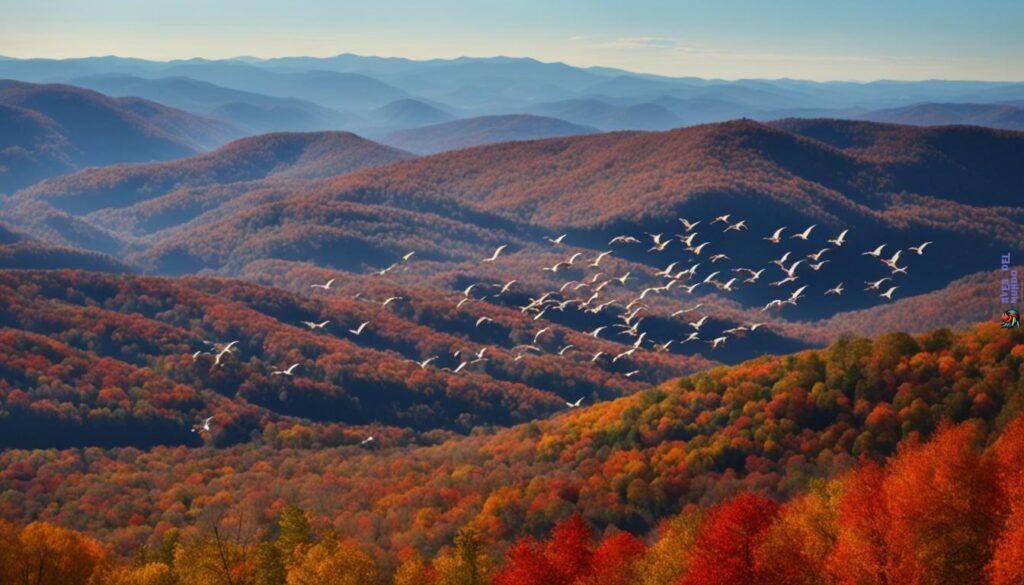
To learn more about the fascinating world of bird migration and the challenges these migratory birds face, continue reading the following sections.
Origins and Triggers of Migration
The origins of long-distance migration patterns are complex and have evolved over thousands of years. Birds migrate to move from areas of low or decreasing resources to areas of high or increasing resources, such as food and nesting locations. The timing of migration can be triggered by changes in day length, lower temperatures, changes in food supplies, and genetic predisposition. Some species, like vireos, flycatchers, and warblers, have evolved from tropical ancestors and continue to migrate to North America for breeding during periods of glacial retreat.
Migratory birds navigate vast distances and face numerous challenges along their routes. Understanding the origins and triggers of migration helps scientists and researchers study these incredible journeys and develop strategies to protect and conserve bird migration patterns in the USA.
The table below highlights the triggers and some notable examples of migratory bird species:
| Migration Triggers | Notable Migratory Bird Species |
|---|---|
| Changes in day length | Red-winged Blackbird (Agelaius phoeniceus) Northern Cardinal (Cardinalis cardinalis) American Robin (Turdus migratorius) |
| Lower temperatures | Snow Goose (Anser caerulescens) Tundra Swan (Cygnus columbianus) Dark-eyed Junco (Junco hyemalis) |
| Changes in food supplies | Ruby-throated Hummingbird (Archilochus colubris) Yellow Warbler (Setophaga petechia) Tree Swallow (Tachycineta bicolor) |
| Genetic Predisposition | Blackpoll Warbler (Setophaga striata) Peregrine Falcon (Falco peregrinus) Monarch Butterfly (Danaus plexippus) |
Image:
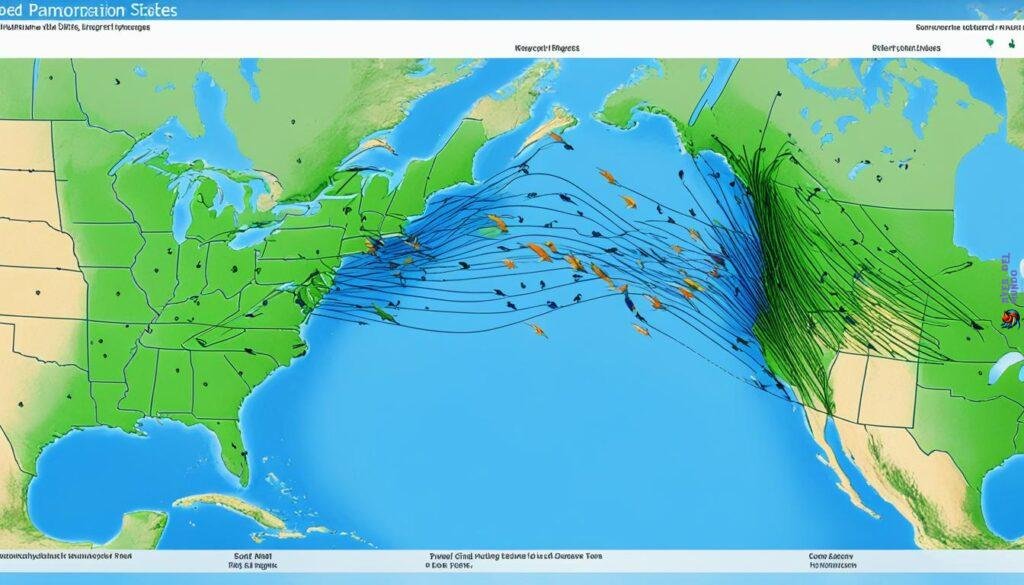
Navigation and Hazards of Migration
Birds have remarkable navigational abilities that enable them to undertake long and perilous journeys during migration. They employ a range of techniques to find their way, including landmarks, environmental cues, and their magnetic sense. Landmarks such as mountains, coastlines, and rivers serve as reliable guides, while the position of the sun, moon, and stars helps them determine their direction.

However, despite their innate navigation skills, birds face numerous hazards and challenges along their migratory routes. Physical stress, caused by the extensive distances covered, can take a toll on their bodies. Additionally, the availability of adequate food during the journey is often limited, leading to hunger and malnutrition. Birds are also vulnerable to unpredictable weather conditions, including storms and strong winds, which can disrupt their flights.
Migratory birds must also contend with increased exposure to predators during migration. As they traverse unfamiliar territories, they may encounter predatory species that pose a threat to their survival. The constant need for vigilance and evasive maneuvers adds an additional layer of complexity to their migratory journeys.
Furthermore, human activities have become a significant hazard for migratory birds. Communication towers and tall buildings pose collision risks, causing fatal injuries to birds in their path. Light pollution, especially in urban areas, can disorient birds and interfere with their ability to navigate accurately.
To further understand the hazards faced by migratory birds, researchers and conservationists are studying these challenges and developing strategies to mitigate their impact. By raising awareness and implementing measures to minimize risks, we can help protect these incredible creatures during their vital migrations.
Migrant Traps and Human Impact
Certain areas, known as migrant traps, concentrate migrating birds in larger numbers. These traps can be caused by favorable weather conditions, an abundance of food, or unique topography. Examples include live-oak groves on barrier islands along the Gulf Coast, which attract exhausted songbirds after flying over the Gulf of Mexico, and peninsulas that become stopover points before birds cross large bodies of water. However, human development, such as hunting, habitat loss, and the presence of tall buildings and communication towers, poses challenges to migrating bird populations.
As human activities expand, migratory birds in the United States face increasing threats to their habitat and survival. Hunting activities, both legal and illegal, disrupt migration patterns and can lead to declines in bird populations. Furthermore, habitat loss due to urbanization and land development restricts the availability of suitable resting and feeding grounds along the migratory routes. The proliferation of tall buildings and communication towers poses a significant risk, with birds often colliding with these structures during their flights.
Examples of Migrant Traps
Let’s take a closer look at a few notable examples of migrant traps:
Barrier Islands along the Gulf Coast
The live-oak groves on barrier islands along the Gulf Coast serve as vital stopover sites for migratory birds. Exhausted songbirds, after crossing the Gulf of Mexico, seek refuge in these oak groves, replenishing their energy reserves before continuing their journey. These groves offer ample food sources and protection from harsh weather conditions, making them attractive sites for migratory birds.
Peninsulas as Stopover Points
Peninsulas, such as the Delmarva Peninsula along the east coast of the United States, act as critical stopover points for birds before they embark on long flights over large bodies of water. These peninsulas provide temporary resting and refueling spots where birds can rest and replenish their energy reserves before undertaking the arduous journeys ahead.
Understanding the significance of migrant traps is essential for implementing effective conservation strategies. It is crucial to protect these areas and mitigate the negative impact of human activities to ensure the survival and well-being of migratory birds in the United States.
| Migrant Trap | Location | Significance |
|---|---|---|
| Barrier Islands along the Gulf Coast | Gulf Coast | Provides crucial resting and refueling sites for birds after crossing the Gulf of Mexico. |
| Delmarva Peninsula | East Coast of the United States | Acts as a stopover point for birds before undertaking long flights over large bodies of water. |
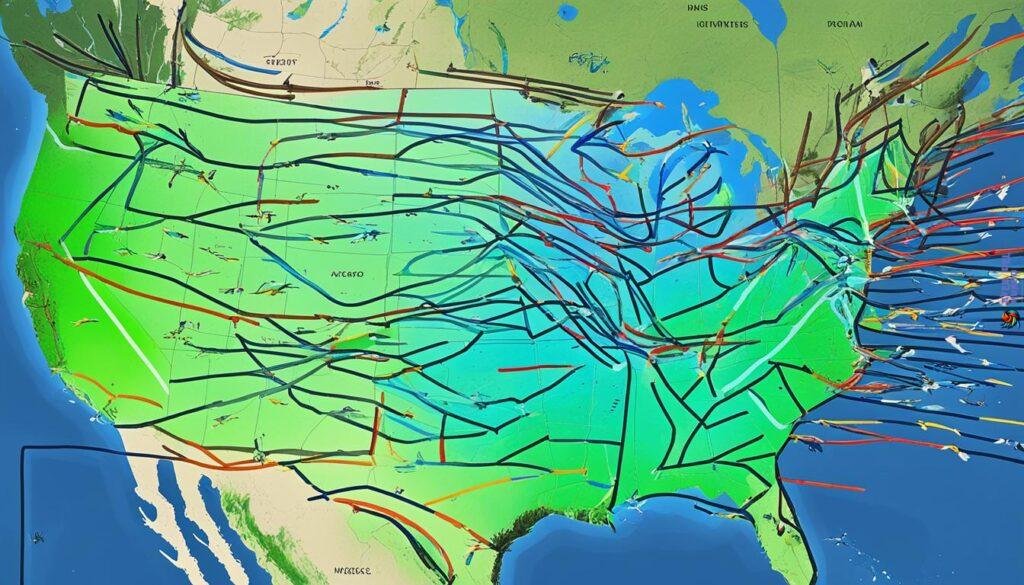
Conservation efforts are vital to protect and preserve these important habitats for migratory birds. By raising awareness, enforcing regulations, and promoting sustainable practices, we can mitigate the human impact on the migration patterns of these remarkable avian species.
Studying Migration and Conservation Efforts
Scientists play a crucial role in understanding bird migration patterns in the USA and protecting the migratory birds in the United States. Using various techniques such as banding, satellite tracking, and geolocators, researchers gather valuable data on the movements of these remarkable avian travelers.
Through the study of migration patterns, scientists can identify important stopover locations where migratory birds rest and refuel during their long journeys. These stopover sites provide essential resources that birds need to survive, including food and suitable habitats. By pinpointing these key locations, researchers can develop conservation strategies to ensure the protection and preservation of these critical habitats.
Preserving these resting and breeding grounds is imperative as habitat loss and climate change pose significant threats to migratory bird populations. By studying the mysteries of bird migration, scientists aim to gain insights that can inform conservation efforts and safeguard the survival of these incredible species and their migration routes in the United States.

